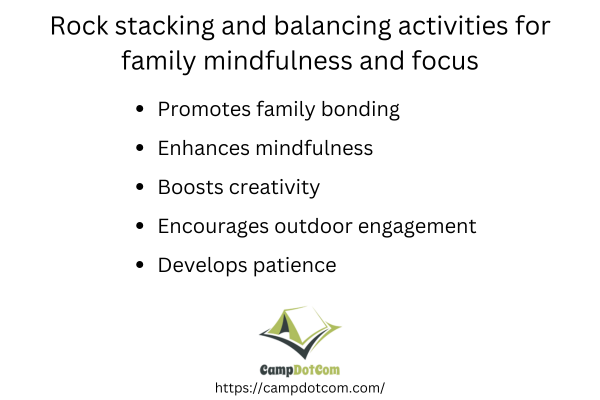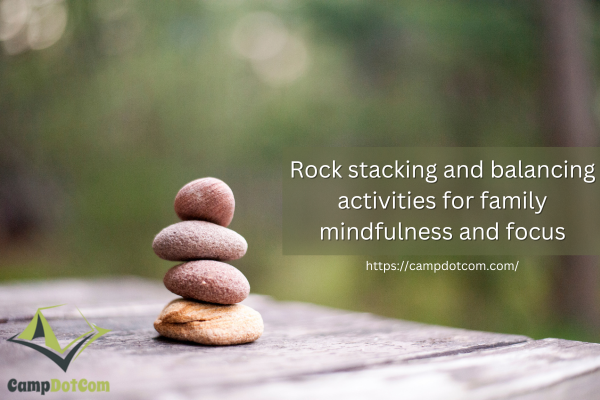Finding moments of calm and focus can be challenging in a world filled with distractions and constant noise. Rock stacking and balancing activities for family mindfulness and focus offer a unique opportunity for families to connect with nature and each other while engaging in a soothing and meditative activity.
Read more about Rock Stacking and Balancing Activities for Family Mindfulness and Focus

More Things To Know About Rock Stacking and Balancing Activities for Family Mindfulness and Focus

As an Amazon Associate, I earn from qualifying purchases. Some of the links in this article are affiliate links. This means that, at zero cost to you, I will earn an affiliate commission if you click through the link and finalize a purchase.
What Is Rock Stacking and Why Is It So Relaxing?
Rock stacking is exactly what it sounds like—carefully balancing rocks on top of each other to create unique formations. But it’s more than just a fun outdoor activity.
It’s been practiced for centuries by different cultures as a form of meditation, artistic expression, and even spiritual rituals.
There’s something deeply calming about finding that perfect balance, feeling the texture of each stone, and adjusting ever so slightly to make it all work.
At first glance, it might seem like luck, but rock stacking actually involves understanding weight distribution, gravity, and stability.
It takes patience and focus—two things we could all use more of. And once you get the hang of it, you might find yourself completely lost in the process (in the best way possible!).
Why Rock Stacking Helps with Mindfulness
Ever notice how focusing on one simple task can make the rest of the world fade away? That’s the magic of mindfulness.
Rock stacking requires your full attention—feeling the weight of each stone, testing different angles, and making tiny adjustments until you find that sweet spot.
It’s the perfect way to be fully present in the moment.
Think of it like meditation but with a hands-on twist. Instead of sitting still and clearing your mind (which can be tough!), you’re actively engaging with nature, using your senses, and letting go of stress.
And the best part?
There’s no right or wrong way to do it. Whether your stack is three rocks high or a towering masterpiece, the joy comes from the process, not the final result.
Making Rock Stacking a Fun Family Activity
If you’re looking for a unique way to bond with your family, this is it! Kids and adults alike will love the challenge of stacking rocks, seeing how high they can go, and even getting a little competitive. Plus, it’s a screen-free activity that gets everyone outdoors and working together.
How to Get Started with Your Family
- Find a good spot: Head to a local riverbank, beach, or even your backyard. Look for a safe, scenic area with plenty of rocks to choose from.
- Let everyone experiment: Give each person a chance to stack their own little tower. No pressure—just fun!
- Add a creative twist: Turn it into an art project by arranging stones in unique shapes or patterns.
- Celebrate successes: Whether it’s the tallest tower or the most creative design, make it a moment to cheer each other on.
Want to make it even more exciting?
Create a mini competition!
Who can build the highest stack?
Who can balance the most unusual-shaped rock?
Just be sure to keep it lighthearted—half the fun is watching those wobbly towers tumble.
Beginner Tips for Rock Stacking Success
Getting started is easy, but here are a few tips to help you master the art of rock balancing:
- Start with a sturdy base. Look for a large, flat rock to build on. It’ll make everything more stable.
- Use different sizes and shapes. Experiment with smaller, rounder rocks on top and wider, heavier ones at the bottom.
- Make tiny adjustments. Sometimes just a tiny tilt can change everything.
- Be patient. Don’t worry if your stack falls—part of the fun is trying again.
Taking Rock Stacking to the Next Level
Once you’ve got the basics down, challenge yourself with more advanced techniques.
Try making an arch, balancing rocks at tricky angles, or even incorporating leaves and twigs for extra flair.
Some people even create gravity-defying designs that look like magic.
And if you’re looking for a real challenge, try stacking rocks in a stream where the water movement adds an extra layer of difficulty. It’s like rock balancing on hard mode.
